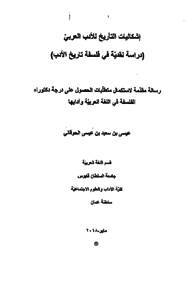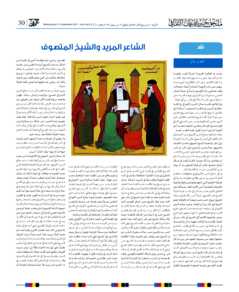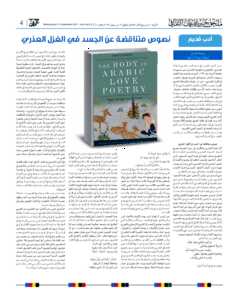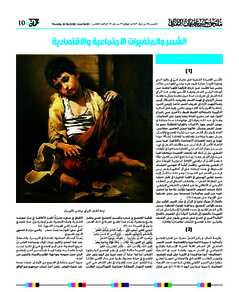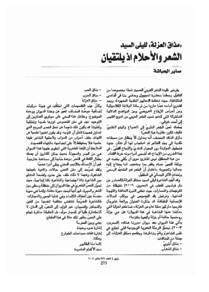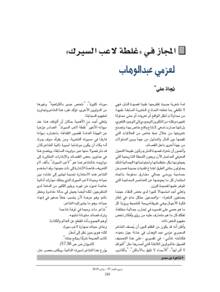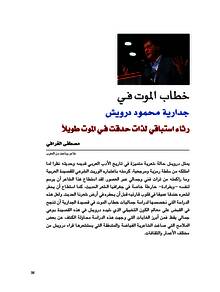Document
التناص في شعر نزار قباني.
Publisher
جامعة نزوى.
Gregorian
2010
Language
Arabic
English abstract
The concept of Intertextuality has appeared on the hand of Julia Krsiteva (1977-1979) who had not brought this concept out of nothing but rather depending on the work of previous researchers. She, moreover, made the door open for other researchers to explore this concept. Therefore, many researchers have written about the theoretical background of this concept as well as its applications. The Arab critics moreover, have their own achievements in enriching the theory and the applications of this concept.
The phenomena of Intertextuality have become a real fact which cannot be denied or ignored when dealing with literature texts, specially that its existence in the modern literature has become a well-known fact. The critic, therefore, has to accept it and dig inside its components to know its sources, types and ways to achieve it.
This study,which has combined the theory and the application of this concept, is to bring the greatest presence of this concept in modern poetry. In order to prove this presence, we have chosen Nizar Qabani poetry which has many applicable illustrations as well as his rich poetic innovation which has different types of poetry purposes.
In order to achieve the goal of this study, we have divided the study into four theoretical and applicable sections. The first section has dealt with the theoretical part of the concept in which we have shown the beginning of the concept in western literature and its roots in Arabic literature and the role of critics to set its theoretical background. In the second section we have discussed the sources of the concept in Nizar Qabani's poetry. In the third section, moreover, we have discussed the direct and indirect types of Intertextuality in Nizar's poetry. In the fourth section we discussed the mechanisms in Nizar's poetry which we have divided them into two parts: personality recalling mechanism and text recalling mechanism
This study has proved the importance of the Intertextuality phenomena in studying poetry in general and the modern poetry in specific since it is hardly to find a poetic text without the application of this phenomena in its different types, techniques and mechanisms.
Member of
Resource URL
Arabic abstract
ظهر مصطلح التناص على يد جوليا كريستيفا في عام ( ١٩٦٦م - ١٩٦٧م) ، وكما أن كريستيفا لم تأت بهذا المصطلح من العدم بل إنها اعتمدت على من سبقها من الباحثين، فهي كذلك بدورها قد مهدت الطريق لمن جاء بعدها، فقد تلقفت أقلام الباحثين هذا المصطلح تنظيرا وتطبيقا، وقد كان النقاد العرب جهودهم في إثراء هذا المصطلح على مستوى التنظير والتطبيق.
وقد أصبحت ظاهرة التناص ظاهرة مسلما بوجودها، ولم يعد بالإمكان إهمالها أو تجاهلها عند دراسة النص الأدبي، لا سيما أن وجودها في النص الحديث بات أمرا بديهيا، وعلى الناقد أن يتقبله وأن يمعن النظر في مصادره و أنواعه وأشكاله والطرق الموصلة إليه.
وتأتي هذه الدراسة جامعة بين الجانبين النظري والتطبيقي لبيان ما لظاهرة التناص من حضور فاعل في النص الشعري الحديث، وإثبات هذا الحضور من خلال استقراء شعر نزار قباني، الذي سوغ اختياره وجود مادة كافية للتطبيق بالإضافة إلى غزارة إنتاجه، وتنوعه بين الأنماط الشعرية المختلفة.
وقد اقتضت منهجية البحث تقسيم الدراسة إلى أربعة فصول، فجاء الفصل الأول نظريا بينا فيه بدايات التناص في النقد الغربي، وبحثنا عن جذوره في النقد العربي ، وتناولنا جهود النقاد في التنظير له. أما الفصل الثاني فقد جاء نظريا تطبيقا عرضنا فيه مصادر التناص في شعر نزار قباني، والفصل الثالث كان نظريا تطبيقيا تناولنا فيه أشكال التناص المباشر وغير المباشر في شعر القباني، ويأتي الفصل الربع كذلك نظريا تطبيقا مشتملا على آليات التناص في شعر نزار ، وقد أوردناها على قسمين آليات استدعاء الشخصيات وآليات استدعاء النصوص.
ولقد ثبت من خلال هذه الدراسة أهمية ظاهرة التناص في دراسة النص الشعري عامة والحديث منه خاصة، حيث لا يخلو نص من النصوص من توظيف هذه الظاهرة بأشكالها وتقنياتها وآلياتها المختلفة.
وقد أصبحت ظاهرة التناص ظاهرة مسلما بوجودها، ولم يعد بالإمكان إهمالها أو تجاهلها عند دراسة النص الأدبي، لا سيما أن وجودها في النص الحديث بات أمرا بديهيا، وعلى الناقد أن يتقبله وأن يمعن النظر في مصادره و أنواعه وأشكاله والطرق الموصلة إليه.
وتأتي هذه الدراسة جامعة بين الجانبين النظري والتطبيقي لبيان ما لظاهرة التناص من حضور فاعل في النص الشعري الحديث، وإثبات هذا الحضور من خلال استقراء شعر نزار قباني، الذي سوغ اختياره وجود مادة كافية للتطبيق بالإضافة إلى غزارة إنتاجه، وتنوعه بين الأنماط الشعرية المختلفة.
وقد اقتضت منهجية البحث تقسيم الدراسة إلى أربعة فصول، فجاء الفصل الأول نظريا بينا فيه بدايات التناص في النقد الغربي، وبحثنا عن جذوره في النقد العربي ، وتناولنا جهود النقاد في التنظير له. أما الفصل الثاني فقد جاء نظريا تطبيقا عرضنا فيه مصادر التناص في شعر نزار قباني، والفصل الثالث كان نظريا تطبيقيا تناولنا فيه أشكال التناص المباشر وغير المباشر في شعر القباني، ويأتي الفصل الربع كذلك نظريا تطبيقا مشتملا على آليات التناص في شعر نزار ، وقد أوردناها على قسمين آليات استدعاء الشخصيات وآليات استدعاء النصوص.
ولقد ثبت من خلال هذه الدراسة أهمية ظاهرة التناص في دراسة النص الشعري عامة والحديث منه خاصة، حيث لا يخلو نص من النصوص من توظيف هذه الظاهرة بأشكالها وتقنياتها وآلياتها المختلفة.
Category
Theses and Dissertations


